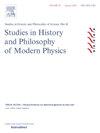Spacetime as a quantum error-correcting code?
Q1 Arts and Humanities
Studies in History and Philosophy of Modern Physics
Pub Date : 2020-08-01
DOI:10.1016/j.shpsb.2020.04.002
引用次数: 6
Abstract
This essay considers an interpretation of the AdS/CFT correspondence under which the bulk and the boundary emerge from a more fundamental discrete system that realizes the structure of an erasure-protection quantum error-correcting code (QECC). I consider the extent to which this view underwrites the claim that spacetime is a QECC (as some authors have suggested), and how it fits into recent schemes of realist interpretations of dualities.
时空是量子纠错码吗?
本文考虑了AdS/CFT对应的一种解释,在AdS/CFT对应下,体和边界出现在一个更基本的离散系统中,该系统实现了擦除保护量子纠错码(QECC)的结构。我考虑了这种观点在多大程度上支持了时空是QECC的说法(正如一些作者所建议的那样),以及它如何适应最近对二元性的现实主义解释方案。
本文章由计算机程序翻译,如有差异,请以英文原文为准。
求助全文
约1分钟内获得全文
求助全文
来源期刊
自引率
0.00%
发文量
0
审稿时长
13.3 weeks
期刊介绍:
Studies in History and Philosophy of Modern Physics is devoted to all aspects of the history and philosophy of modern physics broadly understood, including physical aspects of astronomy, chemistry and other non-biological sciences. The primary focus is on physics from the mid/late-nineteenth century to the present, the period of emergence of the kind of theoretical physics that has come to dominate the exact sciences in the twentieth century. The journal is internationally oriented with contributions from a wide range of perspectives. In addition to purely historical or philosophical papers, the editors particularly encourage papers that combine these two disciplines.
The editors are also keen to publish papers of interest to physicists, as well as specialists in history and philosophy of physics.

 求助内容:
求助内容: 应助结果提醒方式:
应助结果提醒方式:


